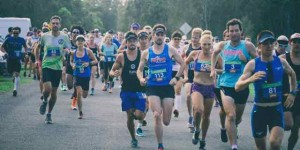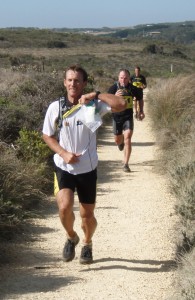Benefits versus Risk of Trail Running
I love trail running, but there are some associated Risks….
Written by APA Titled & Olympic Sports Physio Britt Caling
There are many benefits of adding a little off-road/ trail running to your run training from both a performance and technique perspective and a reduction in the risk of injury. However, there are also some risks associated with hitting the trails. Below I discuss the benefits and risks of trail running from an injury perspective:
 Benefits:
Benefits:
– Running on dirt, trail or even rocky surfaces means for a softer surface at foot strike which reduces the impact forces transferred to the body. This will reduce your risk of bone stress reactions and stress fractures. If you are an athlete who experiences regular shin splint pain with road running or if you have experienced a bone stress injury that has limited your running then adding some trail running to your training may be useful to avoid missing run training due to soreness or injury.
– Trail running, especially rocky surfaces, means that each foot strike tends to be different. This helps reduce recurrent and repeated impact forces and reduces your risk of repetitive overuse injuries such as bone stress, ITB friction syndrome and some hip injuries.
– Running uphill and technical trails means you will naturally shorten your stride length. This is great for runners who regularly over-stride and have injuries related to this, including shin splits, ITB friction syndrome, hamstring tendon pathologies and patellofemoral joint knee pain.
– If you include uphills in your trail running, there is an overall additional strength loading on your tissues, especially your glut maximus, hamstrings and calf/achilles.
– Trail running is great for improving ankle and foot strength and stability.
 The main risks associated with trail running are related to acute trauma or too much steep hill running and include:
The main risks associated with trail running are related to acute trauma or too much steep hill running and include:
– Ankle sprains and other injuries (such as a small bone fracture in ankle, fibula or toes or a peroneal tendon tear) associated with an ankle/foot twist episode. When running on technically challenging surfaces (particularly rocky or slippery surfaces) you may step on a rock/branch/acutely angled surface that can cause excessive stretching forces to tissues and then damage to these tissues. The best way to prevent this is to tape your ankles and learn the skill of running off-road (ie where to look when running and how to place your foot). Other balance exercises can be used to help you develop strong feet and ankles. Also, if you are running on a very challenging surface, be cautious with your speed until you have stronger feet and ankles and are technically better at running off-road.
– Knee ligament sprains. Again, stepping on a surface that may move or cause you to slip can put your knee in an awkward position that can overstress your ligaments. The prevention for this is as above for acute ankle injuries.
– Low back pain. When running uphill (and particularly long or steep hills like you often get trail running) you will lean forwards at your trunk. Low back pain can therefore result from adding steep hills into your run when you are not conditioned to them or if your low back muscles are too weak to hold your trunk posture. To prevent this, be sensible with the addition of hills into your training; consider using walking poles (I prefer to call them running poles!) if the hill is very steep and/or will involve hiking; and do some back strengthening exercises such as plank holds as part of your training week.
– Patella Tendon (in the knee) overload and patellofemoral (kneecap-to-thigh) joint pain. This will usually only result from excess, steep hill training with not enough recovery on your tendon and not enough maintenance (ie massage) on reducing the extra tension in your quads muscles that develops from lots of hill running. Prevent these problems by being smart with your training program and include recovery plus a gradual introduction of hills, and make sure you get regular massage, or at least do your own massage, foam roller or trigger-pointing.
– Foot pain. If the off-road surface you are running on is rocky and you are wearing shoes with inadequate support or grip then your feett can move around excessively in your shoe and your forefoot (front of foot) or rearfoot (heel) can be put under greater mobility stress. This can cause some foot soreness or stress to your plantar fascia so ensure you wear correct off-road shoes.
My final piece of advice: if you are new to off-road running, take a phone with you just in case an injury were to happen and you need to call for help.
Otherwise, make the most of appreciating the beautiful environment you are running in and stay safe!
